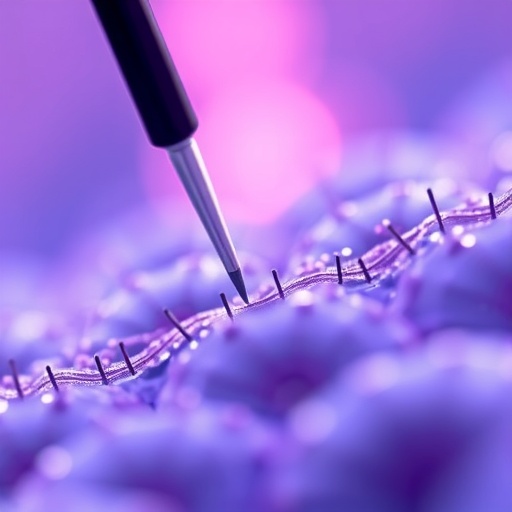In the ever-evolving field of cancer treatment, a groundbreaking approach is coming to light, unveiled by a recent study focused on rectal cancer. Researchers have made significant strides in enhancing drug delivery systems, particularly through the development of dissolving microneedles. These innovative devices have demonstrated the potential to revolutionize the way therapeutic agents are administered, particularly for patients battling rectal cancer. The study highlights how these microneedles can effectively deliver Oxaliplatin, a chemotherapeutic agent, along with sodium butyrate, via outer membrane vesicles (OMVs).
Rectal cancer poses a formidable challenge, characterized by difficult treatment regimens and significant side effects from conventional therapies. Current treatments often involve systemic chemotherapy, leading to numerous unwanted effects that can diminish the quality of life for patients. The need for targeted therapies that minimize systemic exposure while maximizing local efficacy is paramount. This is where the novel use of dissolving microneedles surfaces as an intriguing solution.
Microneedles are tiny, often microscopic, needles that can penetrate the skin barrier painlessly. By delivering drugs directly to the affected area without the need for invasive procedures, they stand to offer a less painful and more efficient delivery mechanism. In this study, the focus is on the unique properties of dissolving microneedles, which can dissolve rapidly upon application, releasing their payload directly into the tissues beneath the skin. This localized approach helps concentrate the therapeutic effects exactly where they are needed.
Outer membrane vesicles, derived from bacterial or mammalian cells, have emerged as promising vehicles for drug delivery due to their biocompatibility and ability to encapsulate therapeutic agents. By loading these vesicles with Oxaliplatin and sodium butyrate, researchers have harnessed a dual-action approach that not only targets cancer cells effectively but also mitigates the side effects typically associated with conventional chemotherapy regimens. The results from preliminary studies indicate that this method could significantly enhance the therapeutic index of cancer treatments.
One of the most exciting aspects of this research is the elaborate methodology employed by the research team to encapsulate and study the delivery of these agents. The researchers optimized the loading and release profiles of the drugs within the OMVs, ensuring that they remained stable during the delivery process while providing a controlled release once administered. This method not only ensures that the drugs maintain their efficacy but also allows for tailored dosages that can be adjusted according to patient needs.
The study also emphasizes how the dissolution characteristics of the microneedles can be fine-tuned to provide continuous drug delivery over an extended period. This characteristic is particularly relevant for cancer treatments, where sustained drug levels can lead to more effective outcomes. By releasing Oxaliplatin and sodium butyrate gradually, the microneedles might reduce the peaks and troughs commonly observed with traditional drug administration, thus leading to more consistent therapeutic effects.
Moreover, the use of dissolving microneedles aligns with the growing trend towards patient-centered healthcare solutions. As patients become more involved in their treatment journeys, options that offer less discomfort and greater ease of use will undoubtedly gain traction. The prospect of self-administration through these microneedles could empower patients, giving them more control over their treatment regimens and potentially improving adherence.
As the scientists behind this study continue to refine their techniques, they also push the boundaries of what can be achieved with drug delivery systems. The integration of biomaterials conducive to both drug stability and patient safety plays a crucial role in this endeavor. The study reports promising biocompatibility results, indicating that the materials used for the microneedles do not elicit significant adverse reactions within the body, which is a key consideration in the design of any drug delivery system.
The researchers are optimistic about the future implications of their work, not only for rectal cancer but also for a broad spectrum of other malignancies. The methodology developed for the encapsulation of chemotherapeutics in OMVs could pave the way for analogous applications in other cancer types and for diverse therapeutic agents. This versatility could prove invaluable in creating tailored cancer therapies that address the unique challenges presented by various tumor microenvironments.
Additionally, the potential for these dissolving microneedles to facilitate combination therapies offers an exciting avenue for research. Combining different mechanisms of action — whether through multiple chemotherapeutics or with immunotherapies — could lead to synergistic effects that enhance overall treatment efficacy. This aligns with the contemporary understanding of cancer treatment as a multifaceted battle that often requires a multifaceted approach.
It is essential to note that, while the preclinical results are promising, the journey from laboratory to bedside is a meticulous process. Further studies, including clinical trials, will be required to fully assess the safety and efficacy of this new delivery method in real-world patient populations. However, the preliminary data certainly ignite hope within the oncology community and for patients afflicted with rectal cancer.
The continuous innovation in drug delivery systems highlights the necessity of interdisciplinary collaboration among scientists, clinicians, and industry professionals. As technology advances, harnessing these innovations to create patient-centric therapies will be crucial. This research exemplifies how a collaborative approach can lead to groundbreaking advancements that could redefine the norm in cancer treatment.
In a landscape where every advancement brings hope for better outcomes, the development and application of dissolving microneedles in delivering potent therapeutics like Oxaliplatin and sodium butyrate mark a significant step forward. With promising results emerging from this study, the potential for transforming the treatment landscape of rectal cancer appears ever clearer. A patient-friendly solution could soon emerge that not only targets cancer effectively but also improves the quality of life for those affected.
In conclusion, as the field of oncology continues to evolve, the intersection of innovation, patient care, and scientific rigor remains at the forefront. The promising research into microneedle technology for cancer treatment not only offers hope for enhanced efficacy but also actuates a more compassionate approach to care. By addressing the complex challenges of cancer treatments with sophisticated delivery systems, the future of oncology therapy looks brimming with potential.
Subject of Research: Delivery systems for cancer treatment using dissolving microneedles.
Article Title: Dissolving microneedles enabled delivery of Oxaliplatin- sodium butyrate loaded outer membrane vesicles against rectal cancer.
Article References:
Jian, C., Zhanbo, Q., Yinhang, W. et al. Dissolving microneedles enabled delivery of Oxaliplatin- sodium butyrate loaded outer membrane vesicles against rectal cancer.
J Transl Med 23, 953 (2025). https://doi.org/10.1186/s12967-025-06921-5
Image Credits: AI Generated
DOI: 10.1186/s12967-025-06921-5
Keywords: Microneedles, Cancer treatment, Chemotherapy, Drug delivery, Rectal cancer, Oxaliplatin, Sodium butyrate.
Tags: cancer treatment advancementschemotherapeutic agents deliverydissolving microneedles for drug administrationenhancing patient quality of lifelocal drug delivery mechanismsmicroneedle drug delivery systemsminimizing chemotherapy side effectsnon-invasive cancer treatment methodsouter membrane vesicles in medicinerectal cancer therapiestargeted cancer treatment innovations





